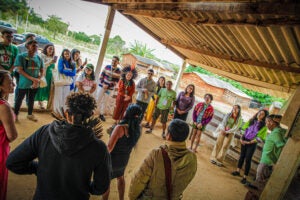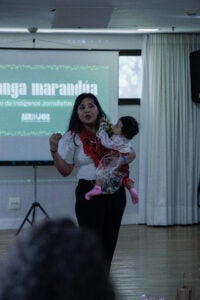Andreza Baré, a 45-year-old journalist from Brazil’s Baré people, has for more than two decades fought against racism and the stereotyping of Indigenous people in her profession.
She’s frequently helped outside reporters understand Indigenous issues, she said, but she often found herself repeating the same lessons – sometimes to the same colleagues.
“It was very tiresome,” she said in an interview with LatAm Journalism Review (LJR). “It was basic information I had already sent in an email, like the name of the Indigenous people, their language, the name of their leaders and their family name. And in the end they publish their story with factual errors as if I hadn’t given them any guidance at all.”
This is why 68 journalists from Indigenous communities across Brazil gathered in 2022 to create a network called Abrinjor (Brazilian Articulation of Indigenous Journalists), and began the process of writing a manual for reporters and researchers who write about Indigenous peoples.
According to Luciene Kaxinawá, 29, a coordinator at Abrinjor, the group includes members from 46 communities from Brazil’s six biological territories, or biomes: Amazon, Caatinga, Atlantic Forest, Cerrado, Pampa and the Pantanal. Some 60 percent of the members are women.

Members of Abrinjor (Brazilian Articulation of Indigenous Journalists) gathered for their first in-person meeting in April 2025 in Brasilia. (Courtesy: Abrinjor)
The manual – named “Poranga Marandúa,” or “Good News” in the Baré language – aims to guide any reporter on how to ethically speak with and about Indigenous people. It was pre-launched this Thursday, Nov. 13, at the 30th annual United Nations Conference of the Parties, known as the COP30, held in the city of Belém in northern Brazil.
The purpose of the event is to help orient journalists reporting from COP30 on how to treat Indigenous people, respect their time and the hierarchies within Indigenous communities and populations, Kaxinawá said in an interview with LJR.
“We decided to do this pre-launch in Belém to bring up some of the terms that will be covered in the manual, such as the term ‘Indian,’ the term ‘tribe,’ the term ‘jungle,’” Kaxinawá said.
Situated in the Amazon rainforest, the conference is in a strategic setting to highlight how to address climate change and the importance of diversifying voices not only in Amazonian issues, but Indigenous themes across Brazil, Kaxinawá said.
“We have always had very solitary careers, very solitary trajectories,” Luan Tremembé, 23, also a coordinator at Abrinjor and himself a journalist since he was 15, told LJR. “So we managed to bring these Indigenous journalists together and we came to the conclusion that the press, the media and even the spaces we occupied in mainstream media don’t know how to cover, talk to or even who to contact when they have stories related to Indigenous issues.”

Luciene Kaxinawá, a coordinator at Abrinjor, speaks at the group’s first in-person meeting, held April 2025 in Brasilia. (Courtesy: Abrinjor)
An early draft of the manual, reviewed by LJR, contains more than 80 pages and focuses on how to not talk about Indigenous people but rather alongside them and from their perspective.
“It was originally created to be just a guide, but it started growing more and more and now it's a full document,” Kaxinawá said.
Sections include: the history of the Indigenous movement in Brazil; the concepts and differences of Indigenous communications and Indigenous journalism; the history of the practice in the country; outdated concepts, with examples of outdated colonial terms; expressions and narratives and a glossary with terms and expressions that guide respectful, accurate and decolonized communication and journalism.
“There’s also an issue of respect for their time and for the Indigenous leaders, because we understand that Indigenous people are leaders as well as our sources,” Kaxinawá said. “There is a specific way to arrive and approach.”
Abrinjor also includes many Indigenous journalists who are researchers pursuing master’s or doctoral degrees in academia. As is the case with mainstream news organizations, academia can be a challenging place for Indigenous people, Baré said.
“I've always been seen as an exotic person,” Baré said, “someone who brings a completely different perspective to the topics of journalism and communication.”
She said that today’s journalists and academic researchers will influence the next generation, Indigenous or not. “It’s very important that people like me are in post-graduate programs,” she said.
For Baré, the new generations of Indigenous journalists must be visible in media and in learning spaces, otherwise the effort to create a manual might be for nothing.
“This is where the new reporters are being trained,” she said, “so it's where we have to be.”
The full manual is scheduled to be launched in February 2026 and will be available in Portuguese on Abrinjor’s website. The articulation is seeking volunteers to help translate the manual to English and Spanish.